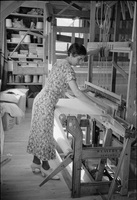 | Back to e-WV
| Back to e-WV
 The West Virginia Encyclopedia
The West Virginia Encyclopedia
 | Back to e-WV
| Back to e-WV
 The West Virginia Encyclopedia
The West Virginia Encyclopedia

Even after the introduction of power looms in the 1830s, much of the fabric used by West Virginians was made at home. Items commonly produced included plain twill blankets, napkins, dish towels, clothing material, and bed coverlets. Coverlets are distinguished by their patterned overshot weave and have become prized heirlooms. Imaginatively named according to their patterns, coverlets are woven according to notation called drafts. These drafts, which look like musical notation and are often undecipherable to the uninitiated, indicate how the threads are to be set up on the loom. Handmade coverlets and other large pieces are always seamed, as the hand looms could not produce work more than about a yard wide.
Weaving was common in rural households throughout the state. The old handmade looms, generally constructed of unfinished lumber or even logs, were sturdy and well-suited to making heavier pieces, such as rag rugs. Such looms had sufficient weight to press the fibers tightly together, making a stiff rug that would lie flat and wear well.
Home weavers used cotton, wool, and, less commonly, flax in their weaving. Often children were recruited to card wool, or to tear rags into strips and sew them into lengths for their mother to weave. Sometimes children would help install the warp, or longitudinal threads, which required walking the length of the finished piece as many times as required for the desired width. The woof or weft, or cross threads, was added as the weaving proceeded.
Often the same household would raise the sheep; prepare the wool; and spin, dye, and weave it. Or wool might be acquired by purchase or barter from others. Sometimes spun thread was bought or traded for from a neighbor, perhaps for a share of the finished weaving. Cotton, which could not be grown in West Virginia, was purchased in bales of raw fiber at local stores. Some flax was grown to make linen, or to mix with wool for linsey-woolsey, despite the elaborate process required to prepare the flax fiber.
Whether wool, cotton, or flax, the fiber was spun into thread on a spinning wheel. Fibers might be dyed before spinning (thus the term, ‘‘dyed in the wool’’) or after it was made into thread. Natural dyes were made from pokeberry for a soft red; walnut hulls and bark for browns; marigolds for yellows; and ragweed for green. Colorfast commercial dyes were available and commonly used by the late 19th century.
Skillful itinerant weavers traveled from house to house in some areas, although this does not seem to have been a common practice in West Virginia. Such weavers used a family’s own thread and loom, applying their superior skill to the work of weaving. Other weavers wove at their own homes for a fee or barter, using thread already dyed and spun by their customers.
The speed of the power loom, introduced about 1835, put some production handweavers, such as the Sloan family at Romney, out of business. Water-powered weaving mills were established at different places in Western Virginia, including Riverton in Pendleton County. The Goodwin family operated a weaving mill at Hollywood, Greenbrier County, in the late 1800s. A cousin of this family, Olive Goodwin, taught many people to weave before her death near Elkins in the 1990s.
Weaving classes were offered at the three federal homestead projects established in West Virginia as part of Franklin Roosevelt’s New Deal during the Great Depression. Promoted by First Lady Eleanor Roosevelt, these projects were at Arthurdale, Eleanor, and Tygart Valley, near Elkins. Eventually some of the looms were sold to women who had taken to the craft, and who continued weaving and went on to teach others. Dorothy Thompson, one of the students and teachers at Arthurdale, would become a longtime fiber arts educator in Tucker and Randolph counties, garnering recognition in 2000 as a National Heritage Fellow.
Though no longer necessary as a home industry, weaving remains a mountain craft with a rich heritage. It is practiced today to a high level of perfection by many craftspeople. There are several guilds active in the state, and the Augusta Heritage organization in Elkins introduces new people each year to the craft while giving experienced weavers an opportunity to refine their knowledge and skills.
Written by Kirsten Milligan
Eaton, Allen H. Handicrafts of the Southern Highlands. New York: Dover Publications, 1973.
Davison, Marguerite P. A Handweaver's Pattern Book. Swarthmore: Marguerite P. Davison, 1944.
Wilson, Kathleen Curtis. Textile Art from Southern Appalachia: The Quiet Work of Women. Johnson City, TN: Overmountain Press, 2001.
Armentrout, Jocie. Interviews by Gerry Milnes. Elkins. 9/14/90.
Coffman, Bernice. Interviews by Gerry Milnes. Elkins. 3/10/92.
Goddin, Sadavoie & Hinkle, Willetta. Interviews by Gerry Milnes. Elkins. 2/19/92.
Goodwin, Olive. Interviews by Gerry Milnes. Elkins. 11/12/90.
Hofer, Genevieve. Interviews by Gerry Milnes. Elkins. 3/16/92.
Marstiller, Rebecca. Interviews by Gerry Milnes. Elkins. 2/20/92.
Teets, Kate & Roy. Interviews by Gerry Milnes. Elkins. 2/24/92.
Thompson, Dorothy. Interviews by Gerry Milnes. Elkins. 4/20/90.
Whetsell, Grace. Interviews by Gerry Milnes. Elkins. 10/6/92.